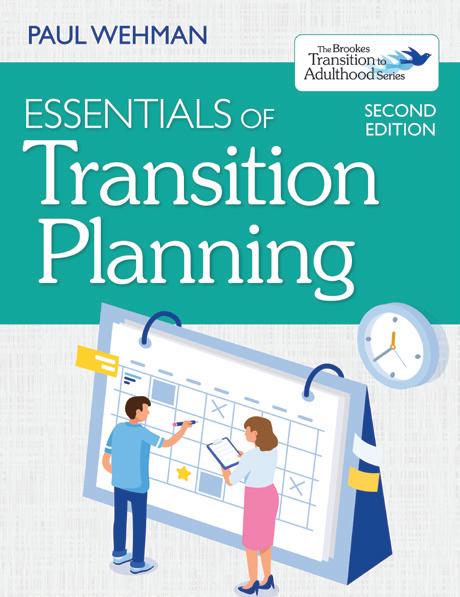
27 minute read
Student Independence Supporting Yourself



Planning the Transition to Employment
By Wendy S. Parent-Johnson, Ph.D. (University of Arizona), Laura Owens, Ph.D. (University of Wisconsin–Milwaukee), & Richard Parent-Johnson, Ph.D. (University of South Dakota)
—Paul Wehman, Ph.D., Virginia Commonwealth University, Richmond
—Richard Luecking, Ed.D., Center for Transition and Career Innovation, University of Maryland
With this practical text, you’ll prepare future professionals to get students with disabilities ready for integrated, competitive employment in the real world. Developed by a team of respected experts, this book embraces the “Employment First” approach to career planning, which emphasizes integrated, competitive employment as the first and preferred option for all people, regardless of disability.
PREPARE PROFESSIONALS TO: • Put together a “collective impact team” to support students’ transition to employment • Apply four recommended practices to help students achieve good employment outcomes • Implement a person-centered planning process that puts the student in the driver’s seat • Help students identify their passions, interests, and learning styles • Support students in exploring careers using online tools and internship opportunities • Facilitate successful collaboration with adult services agencies • Work with local business community to connect students with potential employers • Provide students with the supports they need for success on the job PRACTICAL MATERIALS: Case studies illustrate how to solve common obstacles to finding and keeping a job, and more than a dozen tools and forms—including the ITAP, the Job Observation Assessment Form, and a sample Employment Proposal—will help professionals in their future careers.
ORDER EXAM COPY ORDER EXAM COPY
CONTENTS
1. Getting Started 2. Strategies to Facilitate Effective Transitions 3. Planning for Employment: Person-Centered
Planning and Adult Agency Involvement 4. Developing Skills, Identifying Passions, and
Exploring Careers 5. Developing Employer Relationships to Create Job
Opportunities 6. Providing Training and Supports While in School and After 7. Ways to Overcome the “Yeah, But…” Syndrome

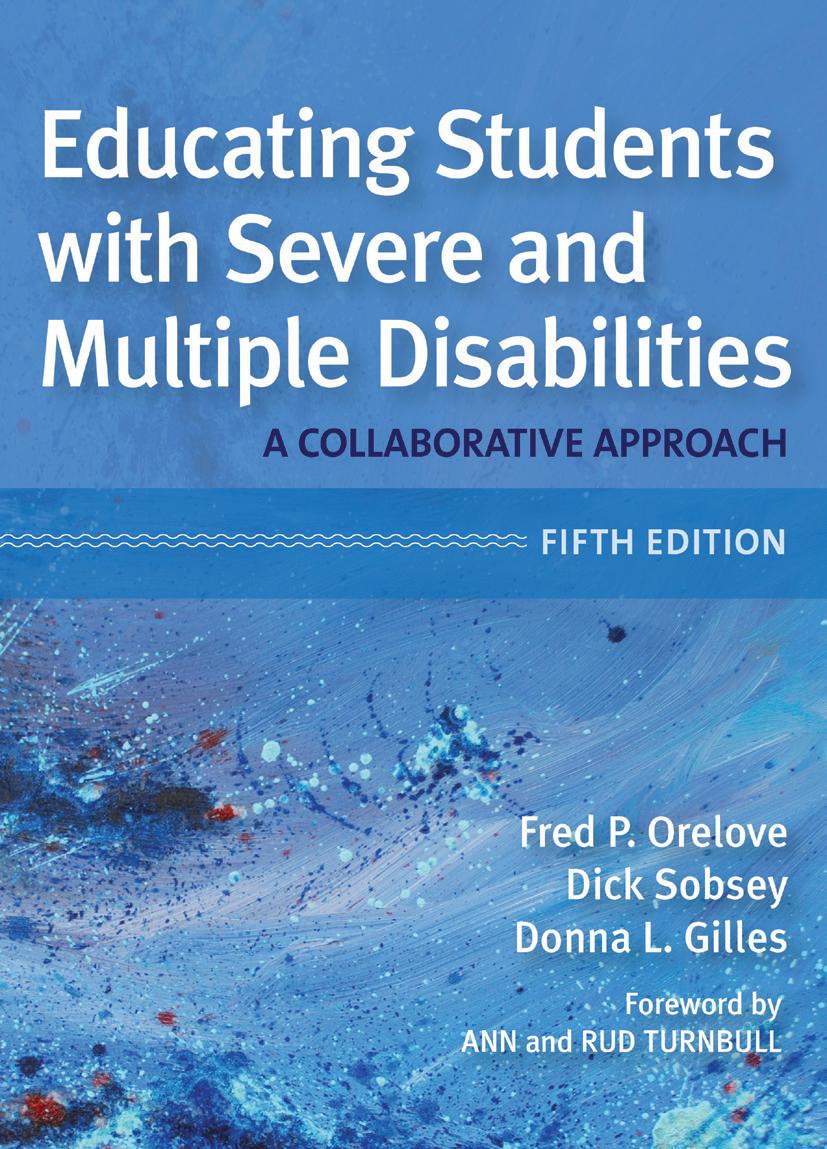
ORDER EXAM COPY

CONTENTS
1. Designing Collaborative Educational Services 2. Partnering with Parents and Families 3. Educating Students with Physical Disabilities 4. Educating Students with Sensory Disabilities 5. Educating Children with Special Health Care
Needs 6. Integrating Health Care in Education Programs 7. Teaching Communication Skills 8. Nutrition and Mealtime Considerations 9. Designing and Adapting the Curriculum 10. Instructing Students with Severe and Multiple
Disabilities in Inclusive Classrooms 11. Creating Educational Adaptations, Accommodations, and Modifications 12. Alternate Assessments for Students with Severe and Multiple Disabilities 13. Transition to Adulthood for Youth with Severe and
Multiple Disabilities

A Collaborative Approach, Fifth Edition
Edited by Fred P. Orelove, Ph.D. (Virginia Commonwealth University), Dick Sobsey, Ed.D. (University of Alberta), and Donna L. Gilles, Ed.D. (Virginia Commonwealth University)
A cornerstone of special education training for nearly 30 years, this is the definitive textbook for preparing educators, counselors, and other related services professionals to teach children with severe and multiple disabilities in inclusive settings. Now in a revised, thoroughly updated, and streamlined fifth edition, this bestselling volume gives current and future educators the research and practical strategies they need to ensure the best learning outcomes for their students. Presenting a team-based, collaborative approach to education, this comprehensive text includes valuable contributions from respected experts in diverse fields, including fresh voices in special education, physical therapy, occupational therapy, communication, counseling, and pediatrics.
WHAT’S NEW: • New chapters on topics essential to effective practice, such as teaching strategies and transition to adulthood • Updates based on the latest developments in special education • Cutting-edge information on assistive technology and understanding challenging behaviors infused throughout the book • New student-friendly features that enhance learning, such as chapter objectives, key terms, reflection questions, and challenging activities • Engaging and instructive case stories at the start of each chapter • New online course materials, including slides that outline key ideas to remember • Helpful new chapter organization that introduces readers to the diverse needs of students with severe and multiple disabilities and follows up with practical teaching strategies
SELECTED TOPICS COVERED: adaptations, accommodations, and modifications • alternate assessments • assistive technology • collaborative learning strategies • communication skills • curriculum design • IEPs • instructional planning • integration of health care and education programs • nutrition and mealtime considerations • partnerships with parents and families • physical disabilities • sensory disabilities • special health care needs • transition to adulthood
US$69.95 | Stock #: 76542 | 2017 | 552 pages | 7 x 10 | paperback | ISBN 978-1-59857-654-2
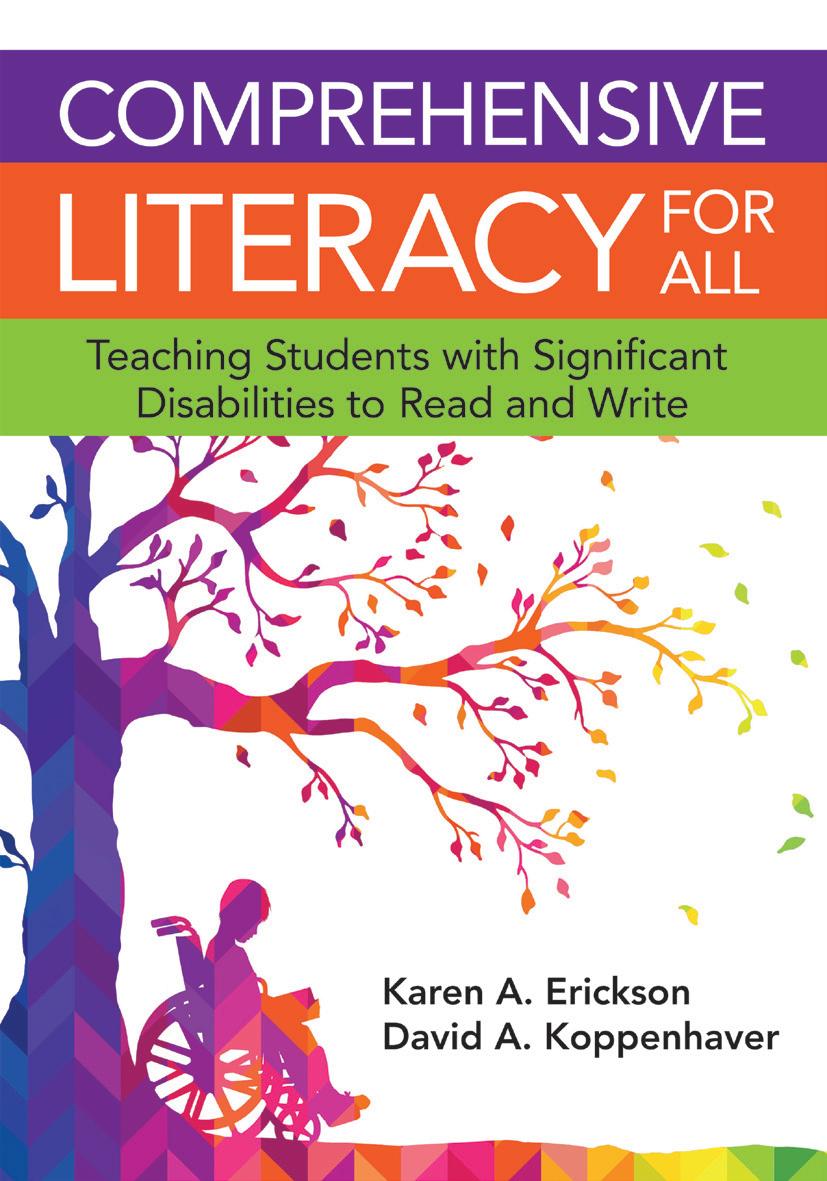



Comprehensive Literacy for All
By Karen Erickson, Ph.D. (University of North Carolina at Chapel Hill), & David Koppenhaver, Ph.D. (Appalachian State University) Literacy improves lives—and with the right instruction and supports, all students can learn to read and write. That’s the core belief behind this student-friendly textbook, an essential guide to providing comprehensive, high-quality literacy instruction to students with significant disabilities.
Drawing on decades of classroom experience, the authors present their own innovative model for teaching students with a wide range of significant disabilities to read and write print in grades preK–12 and beyond. Foundational teaching principles blend with concrete strategies, step-by-step guidance, and specific activities, making this textbook a complete blueprint for helping students acquire critical literacy skills they’ll use inside and outside the classroom.
An ideal text for courses that cover literacy and significant disabilities, this book will help future educators ensure that all students have the reading and writing skills they need to unlock new opportunities and reach their potential.
PRESERVICE EDUCATORS WILL: • Discover 10 success factors for helping students with significant disabilities become literate • Prepare to teach emergent readers and writers skillfully, with evidence-based strategies for shared and independent reading, early writing instruction, and alphabetic and phonological awareness • Learn how to help students acquire conventional literacy skills, with adaptable strategies for teaching reading comprehension, vocabulary, writing, decoding, and spelling • Get ready to organize and deliver comprehensive literacy instruction in a variety of settings, both inside and outside of school • See how to use assistive technology effectively to support reading, writing, and communication • Learn tips on how to engage and motivate students and make literacy instruction meaningful to their everyday lives PRACTICAL MATERIALS: Sample teaching scenarios and dialogues, how-to strategies, and downloadable resources, including sample lessons, a quick-guide to key literacy terms, lesson sequences, and flowcharts to guide instruction.
NEW
ORDER EXAM COPY
CONTENTS
I. CORE UNDERSTANDINGS 1. All Children Can Learn to Read and Write: A
Theoretical Rationale 2. Establishing the Environment for Successful
Literacy Learning II. BUILDING A FOUNDATION 3. Alphabet Knowledge and Phonological Awareness 4. Emergent Reading 5. Emergent Writing III. LEARNING TO READ AND WRITE 6. Comprehensive Literacy Instruction: A Research-
Based Framework 7. Reading Comprehension and Vocabulary
Instruction 8. Self-Directed Reading: Supporting Motivation and
Fluency 9. Writing 10. Decoding, Word Identification, and Spelling IV. IMPLEMENTATION 11. Using Assistive Technology Effectively to Support
Literacy 12. Organizing and Delivering Effective Instruction

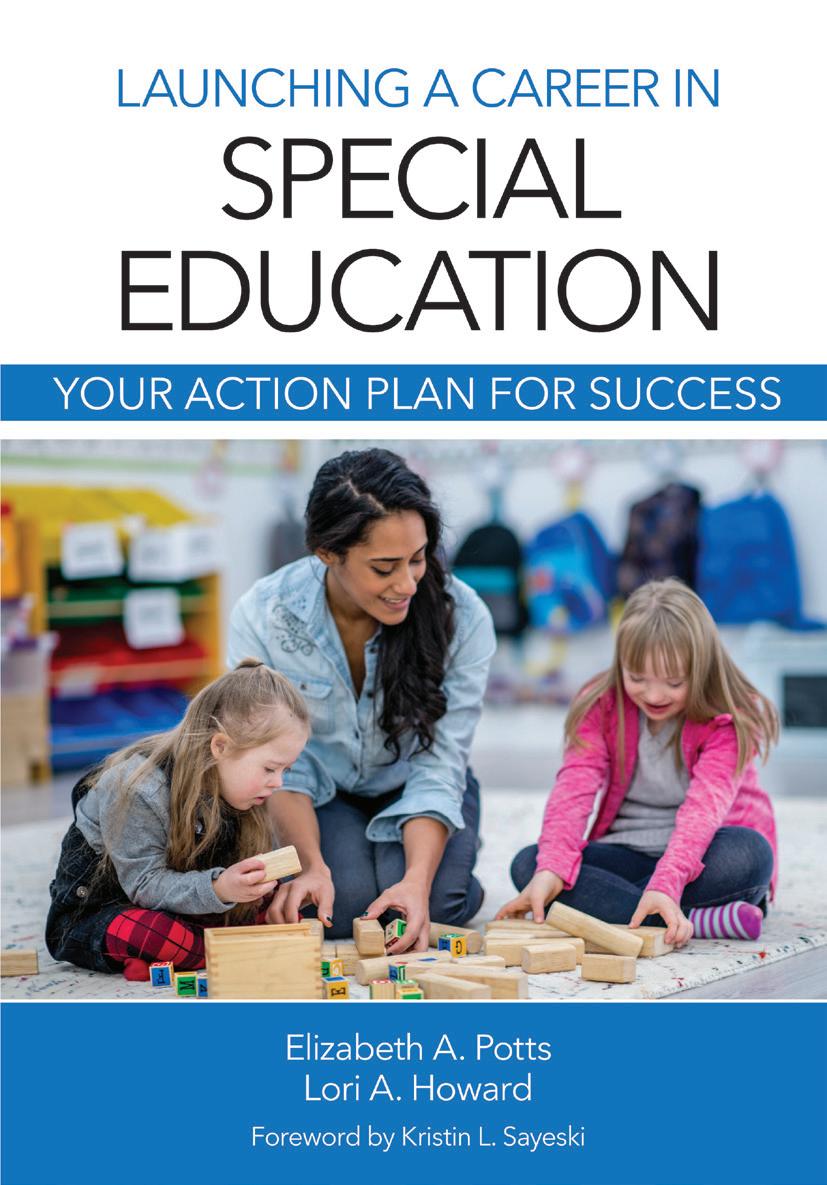
ORDER EXAM COPY

CONTENTS
I. INTRODUCTION 1. Getting Started II. THE DAILY WORK OF A TEACHER 2. Understanding Inclusion 3. Lesson Planning 4. Research-Based Interventions 5. Classroom Assessment 6. Classroom Management 7. Behavior Management III. BEYOND INSTRUCTION 8. IEP: The Legal Document 9. Classroom Observations IV. WORKING AS A PROFESSIONAL WITHIN
A SCHOOL 10. Cooperating Teacher: Your New Best Friend and Mentor 11. Professionalism 12. Co-Teaching 13. Communicating with Others 14. Teaching as a Career

Launching a Career in Special Education
Your Action Plan for Success
By Elizabeth A. Potts, Ph.D., (University of Virginia) & Lori A. Howard, Ph.D. (Marshall University)
For new special educators, navigating the first few years on the job can be a complex challenge. Prepare your students for their future career with this positive and practical resource, a friendly guide to successfully applying knowledge from teacher prep programs to realworld classrooms.
Developed by two special education experts with decades of experience, this book gives future teachers a complete action plan for on-the-job success—from managing everyday details like paperwork and classroom routines to mastering big-picture strategies for behavior management, collaboration, and assessment. Potts and Howard speak directly to your students, talking them step by step through key procedures, addressing common questions and concerns, and giving them sound advice they can use for their whole career. Throughout the book, relatable quotes from new and seasoned educators offer real-world perspectives on the joys and challenges of teaching. An important supplemental textbook for the next generation of special educators!
PREPARE TEACHERS TO: • Set up a classroom • Craft IEPs that reflect the student’s and family’s needs and goals • Plan differentiated lessons that address IEP goals • Find, use, and evaluate evidence-based practices • Choose or develop classroom assessments that are reliable and valid • Use positive strategies to reduce challenging behavior • Prepare themselves and their students for a classroom observation • Demonstrate professionalism in everything from attire to online conduct • Collaborate effectively with other teachers, paraprofessionals, administrators, and support staff PRACTICAL MATERIALS: In each chapter, Planning Timeline boxes highlight which tasks to do when; Special Topics boxes guide readers through key issues related to ethics, co-teaching, and English language learners; and Reflection boxes offer activities and checklists to help your students apply what they learn.



A Comprehensive Guide to Intellectual and Developmental Disabilities
Second Edition
Edited by Michael L. Wehmeyer, Ph.D., Ivan Brown, Ph.D., Maire Percy, Ph.D., Karrie A. Shogren, Ph.D., & Wai Lun Alan Fung, M.D., Sc.D.
The trusted core disability textbook gets a comprehensive update in this second edition, now thoroughly revised to include all the critical topics today’s professionals need to know about as they work with people who have disabilities. Brought to you by a new team of world-renowned experts and contributors, this volume fully prepares future educators, social workers, researchers, and clinicians to provide the best services and supports to children and adults across the life span. Tomorrow’s professionals will discover what to do and how to do it as they prepare for their important work, and they’ll refer to this user-friendly compendium year after year for information, insights, and answers. A cornerstone text for any course focused on developmental disabilities.
THE IDEAL CORE TEXT FOR DEVELOPMENTAL DISABILITY COURSES: • Broad and deep, with thorough, up-to-date information on intervention, education, family roles, health issues, specific disabilities, and much more • Life-span-focused, with topics ranging from genetics and development to aging issues • Multidisciplinary, blending research and personal experiences of more than 70 esteemed authors from diverse fields • Immediately applicable, presenting both the facts and practical, real-world advice on meeting the individual needs of people with disabilities • Student-friendly, with learning objectives, instructive case stories, stimulating questions for reflection, and key Internet resources
SELECTED TOPICS COVERED: assessment and diagnosis • behavior and mental health • brain plasticity • cerebral palsy • decision-making and consent • direct support professionals • Down syndrome • early development and intervention • education • employment • epilepsy • fetal alcohol spectrum disorder • fragile X syndrome • gender issues in developmental disabilities • international human rights • nutritional considerations • parenting • physical health • service systems and approaches • transition from school to adult life

ORDER EXAM COPY
CONTENTS
I. INTELLECTUAL AND DEVELOPMENTAL
DISABILITIES IN TODAY’S CONTEXT II. HUMAN DEVELOPMENT III. ETIOLOGY AND CONDITIONS IV. SUPPORT AND INTERVENTION V. INTELLECTUAL AND DEVELOPMENTAL DISABILI-
TIES THROUGH THE LIFE SPAN VI. HEALTH VII. THE FUTURE
WHAT’S NEW: • New co-editors and contributors • New and extensively updated chapters on critical topics, including AAC and technology, autism spectrum disorder, advocacy and self-advocacy, communication challenges, family issues, human development and genetics, legal and ethical considerations, and psychopharmacology

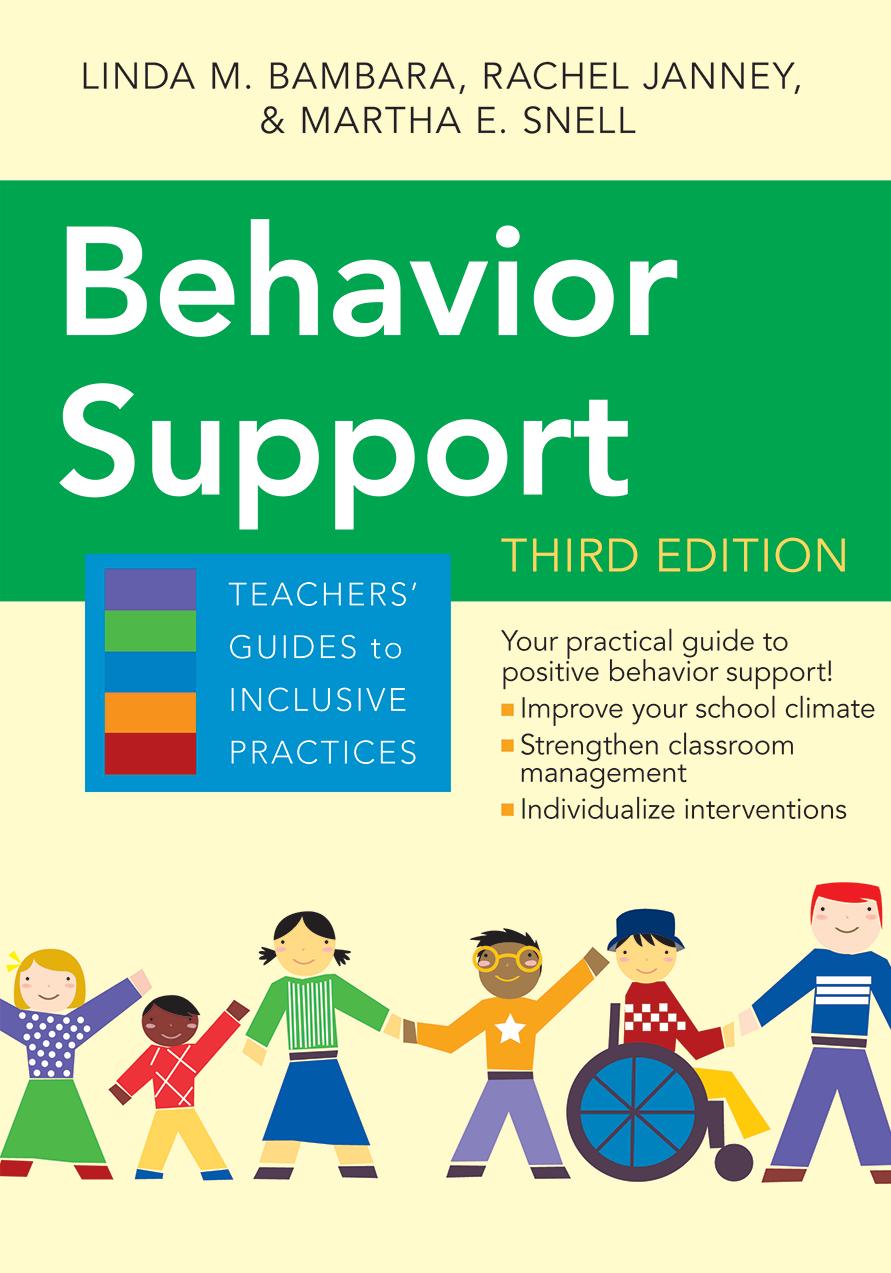


ORDER EXAM COPY
SELECTED CONTENTS
POSITIVE BEHAVIOR SUPPORT 1. Three-tiered Model of School-wide Systems for
Student Support 3. Core Features and Principles of Positive Behavior
Support 4. Positive Behavior Support Teams SCHOOL-WIDE POSITIVE BEHAVIOR SUPPORT 6. A Safe and Responsive School Climate 7. School-wide Unified Discipline Approach 8. Active Development of Social and Emotional
Competencies 9. Bully Prevention in Positive Behavior Support CLASS-WIDE AND SELECTED INTERVENTIONS 11. Class-wide Interventions 12. Team Facilitation of Selected Interventions 13. Identifying Students of Selected Interventions 14. Matching Identified Students with Selected Interventions: Simple Functional Behavioral Assessment 15. Adopting and Implementing Selected Intervention 16. Monitoring, Evaluating, and Sustaining Selected
Interventions INDIVIDUALIZED POSITIVE BEHAVIOR SUPPORT: CONDUCTING A FUNCTIONAL BEHAVIORAL ASSESSMENT 18. 1: Identify the Problem(s) and Decide on Priorities 19. 2: Plan and Conduct the Functional Behavioral Assessment (FBA) DESIGNING, USING, AND EVALUATING INDIVIDUALIZED POSITIVE BEHAVIOR SUPPORTS 20. 3: Design an Individualized Positive Behavior
Support Plan 21. 4: Implement, Monitor, and Evaluate the Positive
Behavior Support Plan
Behavior Support
Fourth Edition
By Linda Bambara, Ed.D. (Lehigh University), Rachel Janney, Ph.D. (independent scholar and consultant), Martha E. Snell, Ph.D., (University of Virginia), with invited contributors
—Tim Knoster, Bloomsburg University
The revised and expanded edition of a popular book trusted in classrooms across the country, Behavior Support is your students’ guide to implementing effective positive behavior support (PBS)—both in the classroom and across an entire school. Future teachers will get explicit, strategies for implementing the three tiers of PBS: universal, school-wide interventions; selected interventions with students exhibiting risk behaviors; and specialized interventions with students who need intensive, individualized help. Packed with strategies, forms, and up-to-date research on multi-tiered systems of support, this practical text will help tomorrow’s teachers support positive changes in students’ behavior.
STRATEGIES FOR HELPING STUDENTS: • Stop challenging behavior before it starts • Improve communication, social, and self-control skills • Form positive, respectful relationships with classmates, teachers, and other community members • Take a more active part in their school, classroom, and community
WHAT’S NEW: More research and strategies on key topics, including bullying prevention, safe and responsive school climates, functional assessment, and individual student interventions. You’ll also get more explicit step-by-step instructions, new case examples, tips on sustaining PBS, redesigned forms, and focusing questions for each chapter that highlight key takeaways.
US$34.95 | Stock #: 78867 | 2015 | 224 pages | 7 x 10 | paperback | ISBN: 978-1-59857-886-7
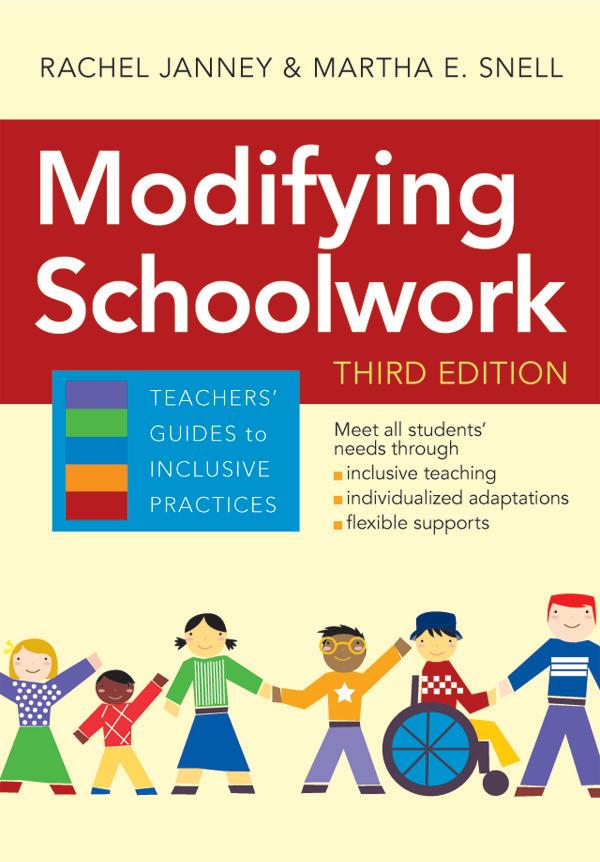



Modifying Schoolwork
Third Edition
By Rachel Janney, Ph.D. (independent scholar and consultant), Martha E. Snell, Ph.D. (University of Virginia)
—Martha Thurlow, Director of the National Center on Educational Outcomes
Your students will keep and use this quick, practical, ready-to-use guidance on teaching all students—and making appropriate modifications for kids who need extra support. This third edition of the bestselling book in the Teachers’ Guides to Inclusive Practices series gives future teachers a clear and concrete plan for K-12 inclusion. Packed with field-tested strategies, case studies, and planning tools, this hands-on guide will show preservice teachers how to deliver effective universal instruction in core content areas and create customized adaptations and flexible supports for students with diverse needs and abilities. The next generation of teachers will learn what really works in inclusion, and they’ll discover how to seamlessly weave in modifications while encouraging each student’s sense of belonging.
NEW TO THIS EDITION: • Practical guidance on implementing Universal Design for Learning • Content aligns clearly with an RTI framework, with strategies spanning from whole-class instruction to highly individualized adaptations • More on working with students with significant disabilities and complex learning needs—one of the biggest challenges of inclusion • Easy-to-print forms that help teachers plan individualized supports and adaptations, available at www.brookespublishing.com • Helpful “focusing questions” at the start of each chapter—perfect for preservice study and teacher book club discussions • New stories from teachers and parents that spotlight real-world challenges and successes
INCLUDES PRINTABLE PLANNING TOOLS: • Team Roles and Responsibilities Checklist • Program-at-a-Glance • Student Profile • General Assessment of Classroom Activities • Program Planning Matrix • Individualized Adaptations and Support Plan
ORDER EXAM COPY
CONTENTS
1. Inclusive Education: The Big Picture 2. Curricular and Instructional Practices that Promote the Inclusion and Success of All Students 3. A Model for Creating Individualized Adaptations and Supports 4. Planning, Implementing, and Evaluating
Individualized Adaptations and Supports for
Students with Extensive Needs 5. Including All Students in Instruction in Core
Curriculum Areas
Appendix A: Blank Forms Appendix B: Resources on Creating Effective Inclusive Schools and Designing Schoolwork for Inclusive Classrooms


ORDER EXAM COPY

CONTENTS
I. THE FOUNDATIONS OF LITERACY AS
A HUMAN RIGHT 1. Literacy for All 2. Developing Language and Communication 3. Addressing Cultural and Linguistic Diversity in
Language and Literacy Instruction 4. Inclusive Literacy Instruction: State and National
Standards and Beyond 5. Creating Accessible, Rich and Engaging Literacy
Environments II. EVIDENCE-BASED COMPREHENSIVE LITERACY
INSTRUCTION 6. Getting the Point: Comprehension Instruction 7. A Broader Approach to Fluency 8. Words, Glorious Words! 9. What’s the Word? Word Recognition Instruction 10. Conveying Your Message: Writing Instruction 11. Organizing Effective Literacy Instruction:
A Framework for Planning III. CREATING OPPORTUNITY AND ACCESS TO
LITERACY IN SCHOOL AND BEYOND 12. Adapting Books and Other Literacy Genres 13. Beyond the Common Core: Art, Music, And
Creativity in Literacy Learning 14. Literacy Beyond High School 15. Where Do We Go from Here?

Effective Literacy Instruction for Learners with Complex Support Needs
Second Edition
Edited by Susan R. Copeland, Ph.D., BCBAD (University of New Mexico), & Elizabeth B. Keefe, Ph.D. (University of New Mexico)
What are today’s best methods for teaching literacy skills to students with complex support needs—including autism, intellectual disability, and multiple disabilities? This comprehensive guidebook has up-todate, evidence-based answers for pre- and in-service educators.
Developed by Copeland and Keefe, the experts behind the landmark book Effective Literacy Instruction for Students with Moderate or Severe Disabilities, this thoroughly reimagined follow-up reflects 10 years of ground-breaking research and advances in the field. You’ll discover current recommended practices on critical topics, including how to build vocabulary, increase word recognition, enhance fluency, address cultural and linguistic diversity, and use academic standards when designing instruction. You’ll also get the guidance you need to put theory into practice: lesson planning strategies, practical examples, and case studies that bring key principles of instruction to life.
Whether used as a text for teachers in training or a guide for practicing educators, this book will help teachers of Grades K–12 increase access to literacy and prepare all learners for successful communication, employment, and community life.
WHAT’S NEW: • New section on literacy as a human right for all learners (the
“why” of instruction) • Chapters on how to design engaging learning environments • Cutting-edge guidance on today’s assistive technology and augmentative and alternative communication • A dedicated chapter on how to use national and state standards in designing instruction • Recommendations for adapting books and other materials to increase all learners’ access • Chapters on combining literacy and the arts to enhance student engagement • More on literacy beyond high school, including community-based learning opportunities




Design and Deliver
Planning and Teaching Using Universal Design for Learning, Second Edition
By Loui Lord Nelson, Ph.D. (Educational Consultant and Owner, The UDL Approach)
—Katie Novak, Ed.D., Novak Educational Consulting
Universal Design for Learning (UDL) is the best way to teach all students effectively and break down barriers to learning. Prepare future educators to embrace and implement UDL with the second edition of this bestselling text, created by internationally recognized UDL expert Loui Lord Nelson. Thoroughly updated to reflect new research and developments, this book gives future K–12 teachers a reader-friendly UDL introduction and a practical framework for implementation, with guidelines and checkpoints for designing effective, barrier-free lesson plans and learning environments.
Preservice educators will learn how to use the three core principles of UDL—Engagement, Representation, and Action & Expression—to present information in multiple ways and ensure access for all learners. Throughout the book, detailed examples, stories, teacher reflections, and activities reinforce UDL principles and help readers put them into practice in both virtual and in-person settings.
WHAT’S NEW: • Key insights from the latest neuroscience research • Useful stories and practical tips from teachers implementing UDL • Technology bytes: timely tips and ideas on how to enhance online learning with UDL • Expert guidance on current topics, including culturally responsive teaching, urban education, and a focus on the expert learner • “Ponder this” prompts throughout the book to help readers discover additional resources • End-of-chapter “check-ins” that help readers apply what they’ve learned
ONLINE MATERIALS: CAST UDL Guidelines; an Identifying Your Resources chart; a UDL design cycle graphic; a UDL lesson plan flowchart; and classroom resource mapping charts for elementary, middle, and high school teachers.
NEW
ORDER EXAM COPY
CONTENTS
I. INTRODUCING UNIVERSAL DESIGN
FOR LEARNING 1. Introducing Universal Design for Learning 2. The Must-Knows of the UDL Framework II. THE PRINCIPLES OF UNIVERSAL DESIGN
FOR LEARNING 3. Engagement 4. Representation 5. Action and Expression III. FROM PLANNING TO PRACTICE 6. The Learning Environment 7. The Goal and the Lesson


ORDER EXAM COPY

CONTENTS
I. UNDERSTANDING TRAUMA 1. Trauma and Its Effects 2. The Role of Attachment in Development 3. Trauma’s Impact on Youth at School II. BUILDING TRAUMA-SENSITIVE SCHOOLS 4. The Trauma-Sensitive School Framework 5. Paradigm Shifts 6. Essentials of Trauma-Sensitive Schools III. IMPLEMENTING TRAUMA-SENSITIVE STRATEGIES 7. Universal Strategies for Trauma-Sensitive Schools 8. Supplemental and Intensive Trauma-Sensitive
Interventions 9. The PACE Approach to Working With Traumatized
Students 10. Trauma-Sensitive Discipline Practices 11. Self-Care for Educators

Building Trauma-Sensitive Schools
Your Guide to Creating Safe, Supportive Learning Environments for All Students
By Jen Alexander, M.A., NCC, SB-RPT
—Jody McVittie, Executive Director, Sound Discipline
In the United States, at least one in four youth experiences trauma severe enough to negatively affect their school success.* Get future educators ready to support students with this ideal supplemental textbook, a reader-friendly springboard for building responsive, trauma-sensitive preK–12 schools. Drawing on her experience as a school counselor, trainer, and mother, Jen Alexander delivers a comprehensive framework for building a supportive school environment that helps all students thrive. Your students will start with an evidence-based introduction to the impact of trauma on a child’s development, attachment, and behavior. Then they’ll get an effective multi-tier system of support (MTSS) for developing a trauma-sensitive learning environment, including both universal strategies (Tier 1) and more intensive interventions (Tier 2 and Tier 3) for students who need more support. PREPARE EDUCATORS TO: • Make five key shifts in the way they view and approach students, so that they’re better equipped to provide support • Implement universal instructional strategies that foster safety, connection, regulation, and learning • Use special supports and coaching when universal strategies aren’t enough • Collaborate effectively with families and colleagues to meet each student’s needs • Incorporate restorative discipline practices that focus on restitution, not retribution • Create a personalized self-care plan to reduce the effects of job-related stress
PRACTICAL MATERIALS: Creative activities for teachers, powerful case stories, sample dialogues and scripts, reflection and brainstorming worksheets, downloadable forms, a sample syllabus, and handouts for use in the classroom.



Pivotal Response Treatment for Autism Spectrum
Disorders, Second Edition
Edited by Robert L. Koegel, Ph.D. (Stanford University School of Medicine), & Lynn Kern Koegel, Ph.D. (Stanford University School of Medicine), with invited contributors
The pioneering experts behind Pivotal Response Treatment have created a comprehensive modern guide to this highly respected, research-based approach, completely reworked and revised for a new generation of therapists and educators. Strengthened with new research and more step-by-step guidance, this bestselling PRT text is now reorganized to support children on their whole developmental trajectory, from infancy through adulthood. New and revised chapters cover critical topics—including assessment and self-management— and the book’s down-to-earth, accessible style ensures that your students can grasp PRT principles and apply them effectively.
With this proven approach backed by more than 25 years of research, future professionals will be ready to support children with autism as they enjoy more positive interactions, more effective communication, and higher academic achievement.
USE THE PROVEN PRT APPROACH TO: • Advance children’s communication and language skills • Aid early identification and intervention • Improve children’s motivation and performance in school • Foster friendships with peers during play dates and other social interactions • Increase positive behavior by combining functional assessment and self-management strategies • Decrease disruptive behavior • Help young adults make a smooth transition to college, career, and community life
PRACTICAL MATERIALS: Each chapter features learning goals, key insights to remember, and helpful study questions (also available online to download and print).
WHAT’S NEW: New and completely reworked chapters on working with infants and toddlers, linking strengths-based assessment to treatment planning, improving adolescents’ communication and social skills, teaching parents how to implement PRT, combining functional behavioral assessment and self-management strategies, helping young adults succeed in college and the workplace.

ORDER EXAM COPY
CONTENTS
I. OVERVIEW: PIVOTAL RESPONSE TREATMENT IN
CONTEXT 1. The History and Basic Components of Pivotal
Response Treatment 2. Assessment, Feedback, and Treatment Planning 3. Ecocultural Theory and Cultural Diversity II. BEGINNING STAGES: EARLY INTERVENTION 4. Intervention for Infants and Young Toddlers 5. Teaching First Words 6. Expanding Friendship Opportunities for Children with ASD III. CHILDHOOD: TREATMENT OPTIONS AT HOME
AND AT SCHOOL 7. Parent Education in Pivotal Response Treatment 8. Inclusive Education 9. Motivational Academics IV. ADOLESCENCE AND YOUNG ADULTHOOD: MOV-
ING TOWARD INDEPENDENCE 10. Functional Behavior Assessment and
Self-Management 11. Improving Communication Skills in Adolescents and Adults with ASD 12. Improving Socialization in Adolescents and Adults with ASD V. ADULTHOOD: HIGHER EDUCATION
AND EMPLOYMENT 13. Improving Outcomes in Higher Education for
Adults with ASD 14. Supporting Individuals with ASD in Employment
Settings


ORDER EXAM COPY

CONTENTS
I. FOUNDATIONAL TOPICS 1. Introduction to Systematic Observation and
Measurement Contexts 2. Validation of Observational Variables 3. Estimating Stable Measures of Generalized Person
Characteristics Through Systematic Observation 4. Designing or Adapting Coding Manuals 5. Coding 6. Common Metrics of Observational Variables 7. Observer Training and Preventing Observer Drift 8. Interobserver Reliability of Observational Variables II. ADVANCED TOPICS 9. Introduction to Sequential Analysis 10. Research Questions Involving Sequential
Associations 11. Generalizability Theory III. PUTTING IT ALL TOGETHER 12. Summary of Recommendations for Best Practices in Observational Measurement

Observational Measurement of Behavior
Second Edition
By Paul J. Yoder, Ph.D. (Vanderbilt University), Blair P. Lloyd, Ph.D., BCBA-D (Vanderbilt University), & Frank J. Symons, Ph.D. (University of Minnesota) An essential textbook for anyone preparing to be a researcher, this comprehensive volume introduces graduate students to key principles of observational measurement of behavior. Based on a course the highly respected authors taught at Vanderbilt University and the University of Minnesota, this text delves deeply into a highly effective approach to observational measurement: systematic observation.
Students will master both the theoretical principles of systematic observation and recommended research methods and techniques. They’ll learn from practical examples that illustrate complex concepts, clear explanations of recommended research methods, definitions of key terms, and exercises and assignments that help them practice putting principles into action. Online companion materials include two six-month licenses for proprietary observational software that students can use to complete the exercises and assignments in this book.
Ideal for use in research methodology courses in diverse fields—including special education, communication sciences, psychology, and social work—this fundamental graduate text will prepare future researchers to skillfully collect, summarize, and communicate their observations of children’s behavior.
STUDENTS WILL: • Fully understand key methods of observational research and measurement • Get comprehensive information on both foundational and advanced topics • Learn from real-world examples based on the authors’ experience • Apply specific recommendations for effective techniques and best practices ONLINE COMPANION MATERIALS: To enhance their courses, instructors will get a full package of online materials, including two six-month licenses for observational software, a media file students can use to practice coding behaviors, a suggested schedule for a semester-long course, exercises for students, and assignments with corresponding grading rubrics.
US$59.95 | Stock #: 52469 | 2018 | 272 pages | 7 x 10 | paperback | ISBN 978-1-68125-246-9

ORDER AN EXAM COPY TODAY
You can request exam/desk copies of up to two books that are relevant to your course needs. If you see a book in this catalog that you’re interested in previewing, please look it up on www.brookespublishing.com, click the Request Exam Copy button found on the book’s page, and complete the request form. (All requested information must be supplied before we can process your order.)
GET COMPANION MATERIALS
The Brookes Download Hub is your home base for the online course materials— slides, test banks, sample syllabi, and more—that come with Brookes books. Sign up with your faculty email address to download companion materials, “favorite” your books to keep track of your online materials, and get free access to companion materials for ALL Brookes books. Registration is easy—sign up today! https://downloads.brookespublishing.com

Brookes Publishing Co. P.O. Box 10624 Baltimore, MD 21285-0624


PAGE 2 PAGE 6 PAGE 11
